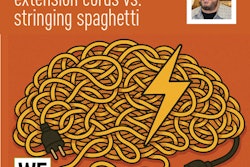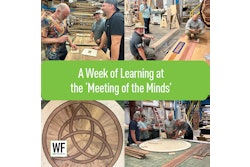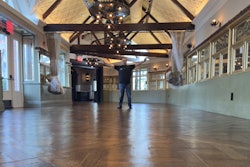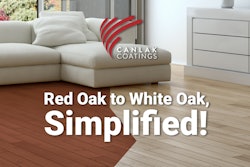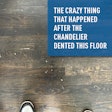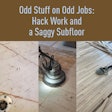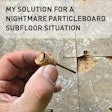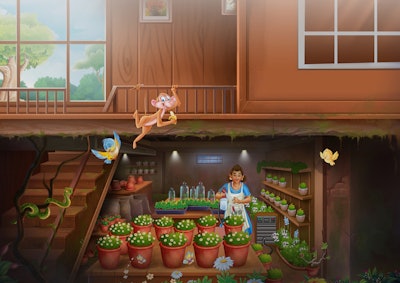
 Illustration by Gayatri Ray
Illustration by Gayatri Ray
A few years back, I inspected a yellow birch prefinished hardwood floor complaint in a $1.4 million residence in an upscale development in Concord, Mass. The photos I received showed the flooring was cupped throughout the first floor of the home. Sales records showed the material was 3 ¼-inch select & better from a reputable Canadian manufacturer. Our retail floor covering dealer requested a full inspection and written report, so I drove to the home for the inspection.
Prior to entering the house I did a site inspection outside the home, because upon arriving I noticed the home was located on a watershed, and the lawn and foundation had glaring signs of erosion. I found 13 downspouts connected to the rain gutter system and not one diverter (elbows, etc.) on any of them. The next thing I knew, I was standing in a hole knee-deep that was created by rain water running straight into the soil and next to the foundation! I entered the home and headed straight for the basement. (Us wood floor pros—dismally accustomed to the anguish and despair brought on by the estranged relationship that is wood and water—all understand that the basement was a smart place to start). I spotted about 2000 square feet of the prefinished yellow birch as I searched for the basement door. Yup, there was cupping and buckling as far as the eye could see. I decided to deal with that later since I already suspected the problem was 8 feet under, so to speak.
The homeowner, we will call her Edna, followed me and my equipment all over the cellar. (We have terminology in the north not everyone may be familiar with: Cellar, Basement, Crawlspace, Bulkhead, Wicked Hahhhdwood Guy … you’ll get the gist of it). She wouldn’t let me focus on anything, constantly verbally assaulting me with: “Are you gonna look at the hahhhhhdwood?” “This is terrible! All this gawldang money and they sell me this … JUNK! They sold us green lumbuh! We paid extra for the pre-fab with the latex and it’s gahhbage!” What moldy, dark corner of the Do-It-Yourself section of the Google Machine taught her these terms?!
Upon inspection, I dubbed Edna’s basement “Sunken Gardens.” Sunken Gardens was literally an Edna-made tropical rain forest. If I had discovered anaconda, venomous spiders or a primate previously missing from the evolutionary scale in this cellar, it would not have fazed me. This was a gloriously beautiful, yet tragic, hardwood floor nightmare.
RELATED: Wood Floor Cupping: Why Does it Happen & What Can You Do?
Sunken Gardens had dozens upon dozens of potted plants and trees. I took the scene all in and then I spotted it—a tiny dehumidifier nested in palm fronds, fiddlehead fern and spider plant stems. If that thing was operational, it was suffering a long, slow death. You might as well have used it to try to dry out the state of Florida. I glanced at it, but there was really no need for inspecting that thing. I gingerly said to Edna, “Uhm, the light is on.” “WHAT?!” She slammed back at me, finally paying attention to anything I was doing. “The red light is on. That means the dehumidifier isn’t working. It might as well be off or broken.” FYI, this was all while I was busy juggling my concrete moisture meter, hygrometer, psychrometer, thermometer, subfloor moisture meter and wood moisture meter, all of which were pegging off the chart’s bad news! I thought it would rain in that basement at any minute.
Edna glared sharply at me and snapped: “If I had to come down here every time that #@$!’N light went on; I’d be down here all day!” Then (no lie!) she pulled the small water bucket from under the dehumidifier and began watering all her plants! How long had she been doing this?! I felt like I was stuck on a broken Busch Gardens tropical adventure ride or damned to an extended luncheon at a Rain Forest Café! And now, I had to “seriously’”discuss the flooring issues at hand with Mother nature herself!
I knew what to do … perplex her and mystify her with my CSI Dog & Pony Show. Enlighten her with the factual knowledge of the problems at hand. All hyperbole aside, an actual greenhouse runs approximately 70–80 degrees Fahrenheit and 65–75% RH at night and 80–90% RH during the day. I showed Edna that Sunken Gardens was 74 degrees F and nearly 65% RH, and the OSB subfloor I tested in the loosely insulated basement ceiling (below the hardwood) read 18+% MC. The invoice from the flooring contractor showed that only red rosin paper was used underneath the hardwood at the time of installation, so the floor had no help there. The concrete basement foundation floor and walls pegged off the meter, so who knows how damp they actually were?! I just knew it was bad. The plants were gorgeous, but the wood flooring above screamed, “Surf’s up!”
I don’t even recall inspecting the actual flooring. That was how hopeless the situation seemed. I am sure I did, and I am equally sure I suggested stabilizing the situation ASAP just to give Edna and her floor guy an ounce of hope. Rain water had been eroding the lawn and soil around the perimeter of the home. The basement was being used as a greenhouse. I politely told her, “Your problem with the flooring above all of this is this heat and humidity. Edna, you are only making it worse watering these plants and keeping the lifecycle going down here. You have created an actual greenhouse in this basement, and you have no insulation or barriers in this ceiling, and I am not even sure that would stop your flooring from cupping. This environment is just too extreme, and the floors were not a consideration when you started this.” I had this image of the birch flooring sprouting back into a beautiful golden-bark sapling.
RELATED: Understand the Science of Water and Wood Floors
Edna’s response? “Oh for God’s sake!” She grabbed the dehumidifier bucket with what was left in it and darted to the basement stairs. She thrust open the bulkhead doors—steel twin doors that covered the stairs and led directly outside. Then, I swear, she planted her feet firmly on the last step or two and contorted her body like a pitcher in his wind-up, and splashed what was remaining in the bucket against the foundation of the house, sending the water into the crushed gravel and, most likely, back into the foundation!
I packed up my bag-o’-tricks, went back to my office, wrote my report, informed the manufacturer they could sleep well that night, and sent my best recipe for damage control to my new friend: Mother Nature Edna. The sea was angry that day, my friends! We moved on. I still don’t know what happened between Edna Nature and my dealer, but I know no one got a free floor. Maybe, possibly, if the installer had known what Mother Nature’s plans were (both Edna and the omnipotent Mrs. Nature), proper steps for external and internal moisture mitigation could have been taken. Proper consideration could have been given to concrete sealers, membranes, rain diverters, applicable underlayment, preliminary testing, environmental controls and, at last, anything but red rosin paper, and the floor might have had a shot at a reasonable existence. Only the basement gators may know.
RELATED: How Inside Air Affects Wood Floors















